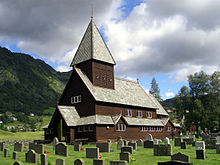Røldal Stave Church
The Stave Church Røldal is a stave church in Norway . It is located in Røldal in the municipality of Ullensvang in the province of Vestland on European route 134 . The church was built around the year 1250; the first written mention was made in 1462.
history
Original construction
The church was originally built as a single-nave hall church. The choir and the nave were the same width. Excavations have shown that the load-bearing posts ( bars ) stood directly on a stone foundation (with sleepers between the posts). These were discovered in 1844 when the church was being rebuilt. A so-called Svalgang existed around the church .
Remodeling in 1844
In 1844 the church was expanded: the interior was raised and expanded to the west.
Restoration from 1915 to 1918
In the period from 1915 to 1918, the church was extensively restored under the architect Jens Z. Kielland . The wall paneling from the 18th century was removed and the furnishings (from the Renaissance ) restored. A new Svalgang was also built around the church.
Most of the medieval construction in the nave and choir, including the associated roofs, has been preserved. Parts of the south portal are also still original. In the church there is a cross from the 12th century, the baptismal font is made of soapstone (probably from the 13th century).
In Bergen Museum a number of parts of the church kept (construction and equipment ). There you will find, among other things, the altarpiece and wooden figures of Olav the Saint (approx. 1250), Our Lady (approx. 1250) and the Archangel Michael (approx. 1200).
today
The church is still used today for church services.
Pilgrimage
On the outside, rather inconspicuous, there are rose paintings by Gottfried Hendtzschel and a crucifix that has been assigned healing powers. The church was one of the most famous pilgrimage churches in Norway from the 13th century . Especially at Saint Hans ( midsummer festival , which is celebrated in Norway on the night of June 24th) there was a large flow of pilgrims . On this day, according to legend, the crucifix began to sweat, triggering a particularly strong, healing effect. Only later did it become apparent that the sweating was triggered by the high humidity in the air of the many pilgrims present.
See also
literature
- Roar Hauglid : Norwegian stave churches . Dreyer Verl., Oslo (Norway) 1977, ISBN 82-09-00938-9 . (German translation; Norwegian original title: Norske stavkirker )
- Erich Burger: Norwegian stave churches. History, construction, jewelry . First published, DuMont, Cologne 1978 (= DuMont-Kunst-Taschenbücher; 69), ISBN 3-7701-1080-3 .
- Yasuo Sakuma, Ola Storsletten: The stave churches of Norway. Masterpieces of Nordic architecture . Approved license edition, Bechtermünz-Verl., Augsburg 1997, ISBN 3-86047-239-9 . (German translation)
- Bugge, Gunnar og Mezzanotte, Bernardino: Stavkirker , Oslo 1993, ISBN 82-504-2072-1
- Bugge, Gunnar: Stavkirkene i Norge , Oslo 1981, ISBN 82-09-01890-6
- Hauglid, Roar: Norske Stavkirker , Oslo 1973
- Jensenius, Jørgen H .: Viking , vol. LXI, 1998: pp. 131-145
Web links
Coordinates: 59 ° 49 ′ 50 ″ N , 6 ° 49 ′ 17 ″ E

